More than 10 years after it was released, watching Pixar's film WALL-E today is a chilling experience.
The backdrop of WALL-E and EVE's robot love story is a dystopian society where humans have abandoned Earth to their trash and left robots to clean up while they cruise space.
When the much-loved animation came out in 2008, it was a bittersweet warning to use less, move more, and stop staring at the damn screen.
But we obviously didn't heed it too well, because as of 2019, we already have an uncomfortable amount in common with the futuristic humans aboard the Axiom spaceship.
The one thing the film's creators were way off on? The timeline. WALL-E is set in 2805 (humans left Earth in 2105), but according to some key measures, we might not be that far off in reality.
Here are nine signs we're going down the same path as the humans in WALL-E.
1. We can't stop buying stuff
Thanks to technological and social advances, every day more people are moving out of poverty and into the consumer class. We're also living in a more peaceful time than ever before. What do we do with all that extra time, energy, and money?
We consume.
 (Walt Disney Pictures/Pixar)
(Walt Disney Pictures/Pixar)
The average US household now owns 300,000 things; 10-year-olds in the UK have 238 toys - but only play with around 12 of them. We shop so much, we increasingly have to rent off-site storage units. And then every few seasons we throw it all out and start again.
With the internet opening up new avenues for consumption - shopping on Instagram, influencer-inspired buying, and now even publishers telling us what to buy - it's not hard to imagine how our desire to buy new things is overwhelming the planet.
The Buy n Large tagline "Too much garbage in your face? There's plenty of space out in space!" playing on loop in WALL-E could easily apply.
We never see the humans of the film before they leave Earth for the Axiom, but based on the waste and omnipresent advertising they leave behind, it's safe to say they liked to shop, too.
So is there a way to keep shopping and avoid that fate? Probably not - in the United Nations' (UN) draft Global Sustainable Development Report 2019, researchers argue that this consumerist system isn't compatible with protecting the planet.
"Economies have used up the capacity of planetary ecosystems to handle the waste generated by energy and material use," the report explains.
2. We're drowning in our own waste
The major plot line of WALL-E is that Earth has been overrun with garbage, making it unsuitable for plant or animal life. The WALL-E robots were tasked with cleaning it up, while humans enjoyed a five-year off-planet cruise (which, spoiler alert, ended up lasting centuries).
While we may not have city-sized trash mounds today, that doesn't mean we don't have a problem with the waste we're spewing out into the environment.
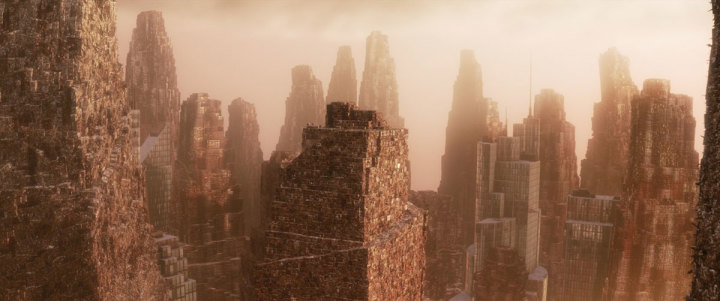 (Walt Disney Pictures/Pixar)
(Walt Disney Pictures/Pixar)
Pollution is already one of the leading causes of death worldwide, killing 9 million people each year and predicted to get worse. A World Health Organisation study last year found that 93 percent of children on the planet are now breathing in polluted air.
With plastic waste and rubbish choking our plants and animals, and human-induced climate change increasing ocean acidification and forest fires, the planet is becoming a less friendly place for life - even our own fertility rates are dropping.
And it's only going to get worse, with China soon refusing to take in any of the nearly 4,000 shipping containers of waste the US sends each day for recycling.
3. We're dominated by mega companies
In WALL-E, society has become dominated by a mega conglomerate punfully called Buy n Large, or BnL. By the time Earth is abandoned, BnL has become so omnipresent, it not only covers cities with its advertisements and discarded products, but also owns the spacecraft humans leave on. It also has the power to declare global emergencies.
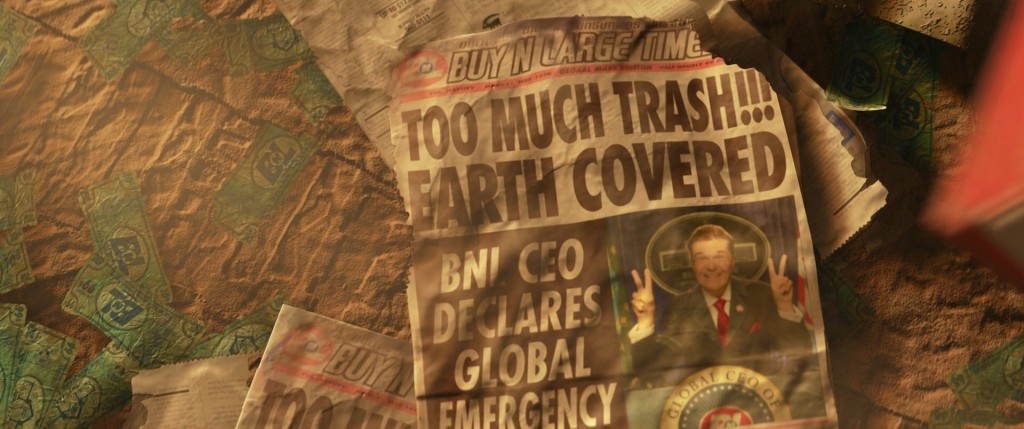 (Walt Disney Pictures/Pixar)
(Walt Disney Pictures/Pixar)
Today, there are just a handful of megacompanies that have huge power of the rest of us and our futures, capable of driving fake news, opioid crises, and covering up climate change.
In fact, just 100 companies are responsible for 71 percent of the world's greenhouse gas emissions.
And while the whole space thing might sound futuristic, don't forget retail giant Amazon not only sells billions of products to consumers all around the world, its founder Jeff Bezos also owns Blue Origin - an aerospace company that aims to help facilitate 'private human access to space'.
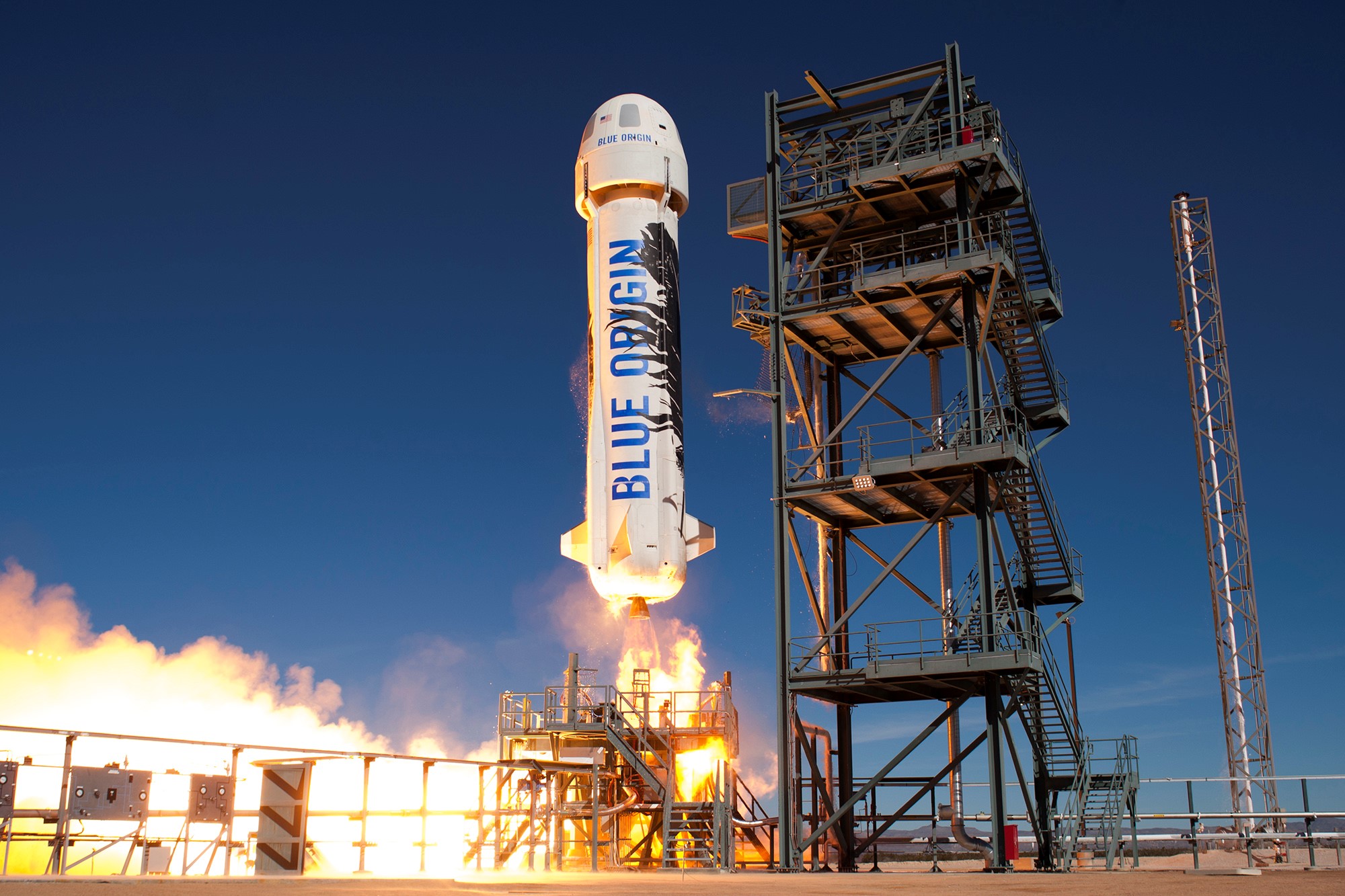 (Blue Origin)
(Blue Origin)
4. We're lonely, despite being more connected
Humans are more connected than ever before thanks to technology, and yet we also report feeling more isolated than ever. In many parts of the world, we're having less sex and birth rates are dropping. Twenty-two percent of millennials say they have "no friends".
This type of empty connection is mirrored in WALL-E, where the robots are more human than the humans are.
On the Axiom, humans have digital screens perpetually beamed in front of their faces that allow them to video chat, but we don't see any intimate family groups. No one touches (until WALL-E and EVE come along), and we don't see couples together, or parents with children - toddlers are raised by AI in classrooms.
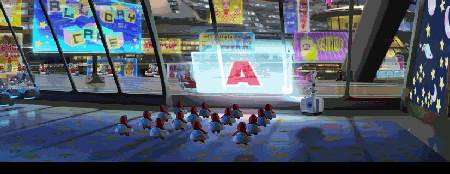 (Walt Disney Pictures/Pixar)
(Walt Disney Pictures/Pixar)
5. Obesity is on the rise
Okay, this one's obvious - one of the most striking things about the humans in WALL-E is that they're all fat. Just look at how the Axiom's captains have changed since the mission launched.
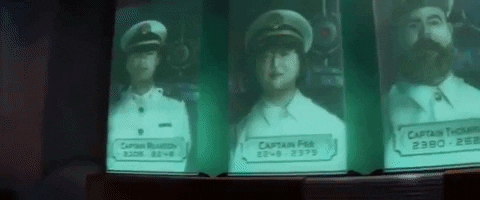 (Walt Disney Pictures/Pixar)
(Walt Disney Pictures/Pixar)
To be fair, space reduces muscle mass and makes you puffy.
But we're not on a dissimilar path of weight gain. Obesity rates have nearly tripled since 1975 and are still increasing.
In the film, it probably has something to do with the fact that people no longer walk. Even as babies, they use self-driving hoverchairs to get them around.
That isn't so far fetched - with self-driving car technology moving out of the lab, and people more sedentary than ever before, it's not hard to imagine us all sitting back and letting technology drive us around.
And then there's this photo, taken in Walmart in 2015:
In fact, BMW has already made something that looks suspiciously like the WALL-E chair, their 'personal mobility concept' vehicle i-REAL.
6. We can't stop staring at screens
I'm not just talking about social media here, but also Netflix, YouTube, Hulu... While we do use technology to connect with friends and family across the globe in ways we couldn't in the past, the average adult today consumes five times more information daily than a counterpart in 1986.
We're also watching close to eight hours of TV a day. Our binge-watching has even become an environmental issue.
The humans in WALL-E are just a small step up from this, with their screens now projected in front of them all the time - giving them 24/7 access to ads, entertainment, and shopping.
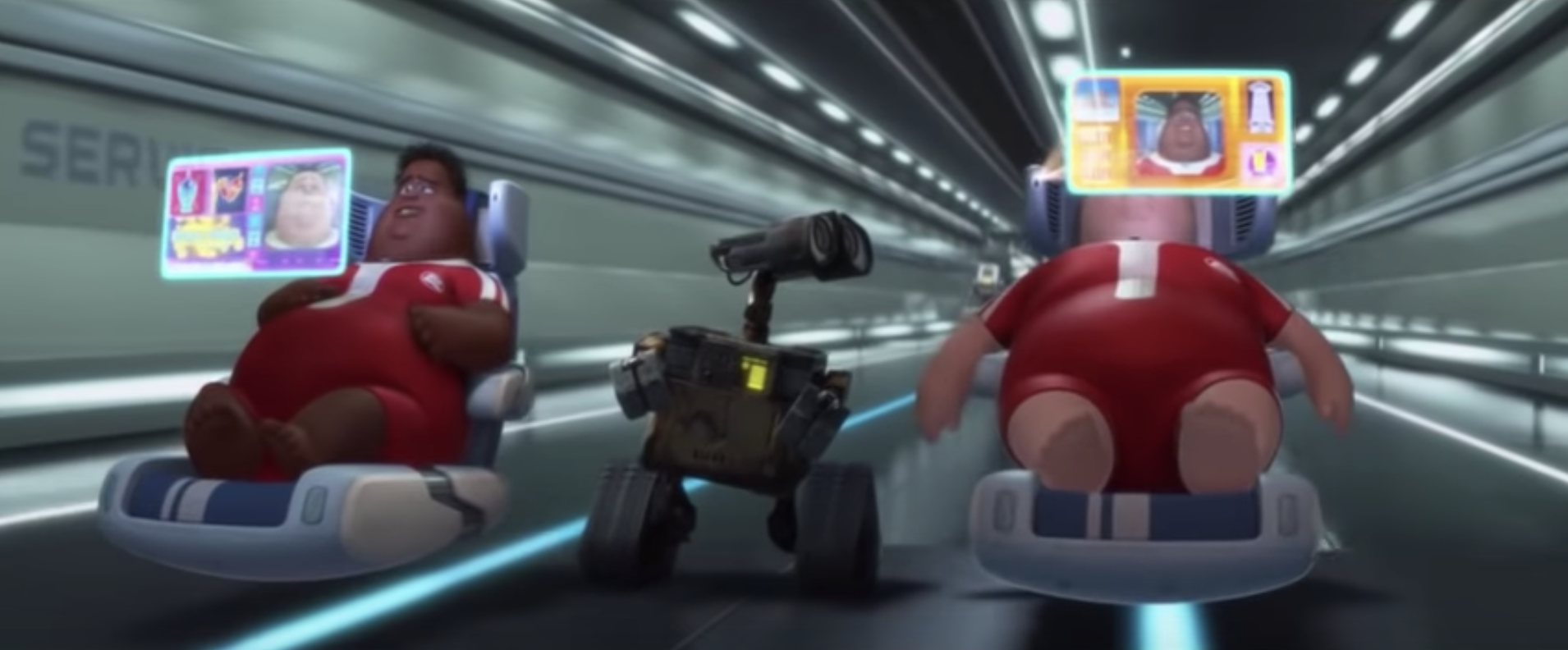 (Walt Disney Pictures/Pixar)
(Walt Disney Pictures/Pixar)
In one telling scene, two friends are chatting to each other online but never realise they're actually right next to each other. Another woman only realises there's a gigantic pool on the cruise ship after her screen is interrupted by WALL-E getting in her way.
Sound familiar?
7. We feel useless
In a crucial line in the film, the Axiom's Captain B. McCrea tells the autopilot "I don't want to survive, I want to live." Up until that point, the only thing he's done himself is read out the morning announcements.
The rest of the humans on board don't seem to work at all. They're purposeless - their roles replaced by technology and their home planet destroyed. Even back on Earth, WALL-E was left behind just cubing up waste and moving it from one place to the next.
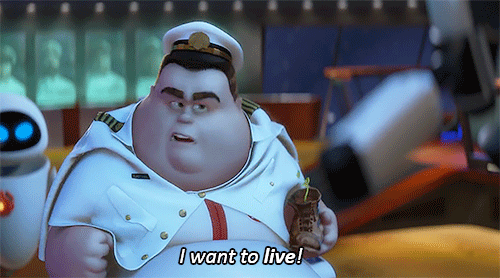 (Walt Disney Pictures/Pixar)
(Walt Disney Pictures/Pixar)
Many of us don't feel much more productive. A 2015 poll in the UK revealed that 37 percent of Brits think their job is meaningless. And scientists have predicted that roughly half of all jobs will be replaced by technology - not centuries from now, but in the next 20 years.
On top of that, we often feel powerless in the face of the climate crisis, with our best attempts at action dwarfed by the negative impacts from industry and government.
8. Going to space might be our only chance of survival... if you can afford it
The Axiom wasn't taking people offshore as a humanitarian act - it was a ticketed, luxury cruise. There's no mention of other evacuation missions from Earth, so if we assume the Axiom is all that's left, what happened to the humans who couldn't afford a ticket?
Probably the same thing that will happen, and is already happening, to those of us who aren't rich enough to be protected from the worst effects of climate change.
Going to space is one option for human survival if our planet becomes so hot that it's no longer habitable. But even with reusable rockets, space is expensive, and there won't be room for everyone.
9. There's still hope
As depressing as the film may be, there's still hope for humanity. Life starts to bloom again on Earth. The antics of WALL-E and EVE wake up the passengers from their mindless scrolling. Captain B. McCrea fights back.
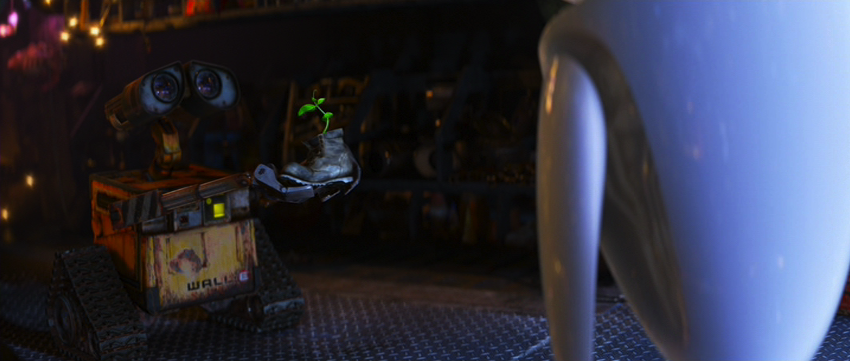 (WALL-E, Walt Disney Pictures/Pixar)
(WALL-E, Walt Disney Pictures/Pixar)
And there's hope for us, too.
Yes, the outlook is bleak, but the science is clear - we can turn this ship around. Every degree of warming we can avoid will save lives, will protect ecosystems.
Perhaps the biggest difference between us and the humans in WALL-E is that we're not useless - yet. We might feel it, but we still have a role to play in stopping the coming climate crisis.
In turning around our mindless consumption. In remembering that we vote governments in to serve our interests, not to protect the status quo. And we shouldn't be scared to vote them out.
This is why we're striking today. There is no news worth covering that could possibly be more important than reminding society that we still have a voice, and we still have power.
This article is part of ScienceAlert's special climate edition, published in support of the global #ClimateStrike on 20 September 2019.
#Humans | https://sciencespies.com/humans/9-ways-todays-society-is-like-the-one-that-filled-earth-with-garbage-in-wall-e/
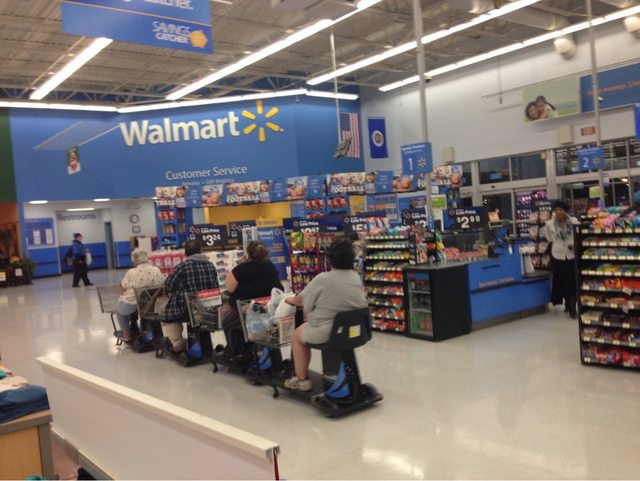

No comments:
Post a Comment